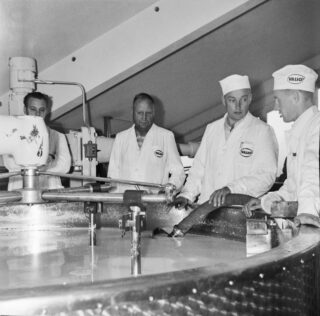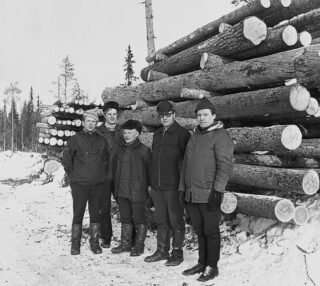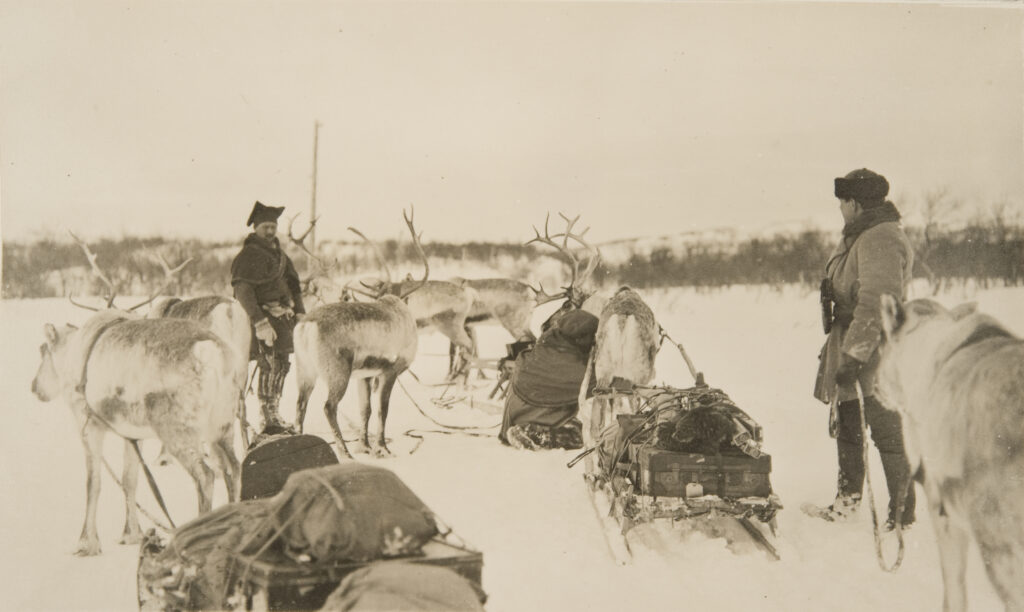Slash-and-burn cultivation came from Savo to the Kuusamo area with the settlers.
Until the middle of the 19th century, the focus was on slash-and-burn and grain cultivation. In Kuusamo, rye, turnip, oats, and potato onions were grown. The ban on the slash-and-burn cultivation led to grain shortages and years of famine, especially in the 1860s. Livestock became the focus of agricultural production. Efforts were made to increase the area of meadows by lowering the waters of the lakes and damming the marshes to form meadows. Cattle feeding moved from forests to pastures demarcated by electric fences. Agriculture began to mechanize and develop strongly.
Kuusamo Osuusmeijeri dairy was founded in 1951.
At the cooperative’s meeting, it was decided that the products would be mostly received as cream. Only the amount needed for local consumption was collected from the surrounding area as milk. In December 1953, it was stated that the quantities of cream and milk were at the level required to build the municipality’s own dairy. In the late summer of 1954, a plot of land for a dairy building was bought from the municipality of Kuusamo, and construction work began in cooperation with Valio. Various products were manufactured until 1989, when the packaging of both butter and milk was stopped in Kuusamo. They were replaced by the utilization of whey produced in cheese making in 1995, the construction of the dairy’s own whey refining plant began. Refining of powders has developed enormously over the years.
In the summer of 1996, Kuusamo Osuusmeijeri founded the processing company JK Juusto Kaira Oy in cooperation with Ingman Foods and Ranuan Meijeri Oy. With the new processing company, the production of cheeses and powders was centralized in Kuusamo. The current millennium has been a time of expansion. In 2002, the cream cheese line was completed and production of Pohjanpoika cheese began. At the beginning of 2012, a new smoking equipment was also put into use for the dairy’s own smoked cheeses.

Forestry in Kuusamo has its roots in the dry distilling of tar in the 19th century.
Tar was mainly produced in Southern-Kuusamo and was transported to Oulu and White Sea. Most of the logs were floated for sawing through the River Iijoki watercourse, but also to the White Sea along the rivers Savinajoki, Aventojoki, Kitkajoki and Oulankajoki. Due to the merits of the waterways, the lumberyards and log floating provided a living for those with small farms and those without a farm.
The First World War closed the border between Finland and Russia and the crossing to the Russian side ended.
A few sawmills operated in Kuusamo in connection with the mills and whetstone factories on the local rapids. The first local steam saw, Kuusamon Puu, started in the church town on the shore of Lake Kuusamojärvi.
Farmer Erkki Virranniemi founded Pölkky Oy in 1968. Pölkky has production facilities in four locations, and the company exports its products to 35 countries. The villa and house factory Kuusamo Hirsitalot Oy, founded by Simo and Arto Orjasniemi and Antti and Jouko Virranniemi, delivers log house packages to Finland and for export.
Founded in 1956, Kuusamo’s collective forest is Finland’s largest and most important player in the Finnish timber trade. The forests of the Kuusamo’s collective forest are in Kuusamo, Suomussalmi, Taivalkoski and Posio. Collective forests are private lands and have no public law character or obligation.

Reindeer husbandry in Kuusamo started with the hunting and taming of the wild deer.
Reindeer became meat cattle in the middle of the 18th century with the settlement. The meat, hides, antlers, and other reindeer products obtained from large herds were sold to White Sea Karelia and on the markets of Oulu and Tornio. Live reindeer were also transported for sale. Reindeer husbandry is still a viable livelihood in Kuusamo. Many have chosen reindeer husbandry: thus, the size of reindeer herds is increasing again, even though the number of herders is decreasing. Along with traditional reindeer herding in Kuusamo, businesses that support it are growing, such as tourism: reindeer have returned to the role of a draft animal in the service of the tourism industry, for example, and reindeer meat production is a significant part of the food industry.
